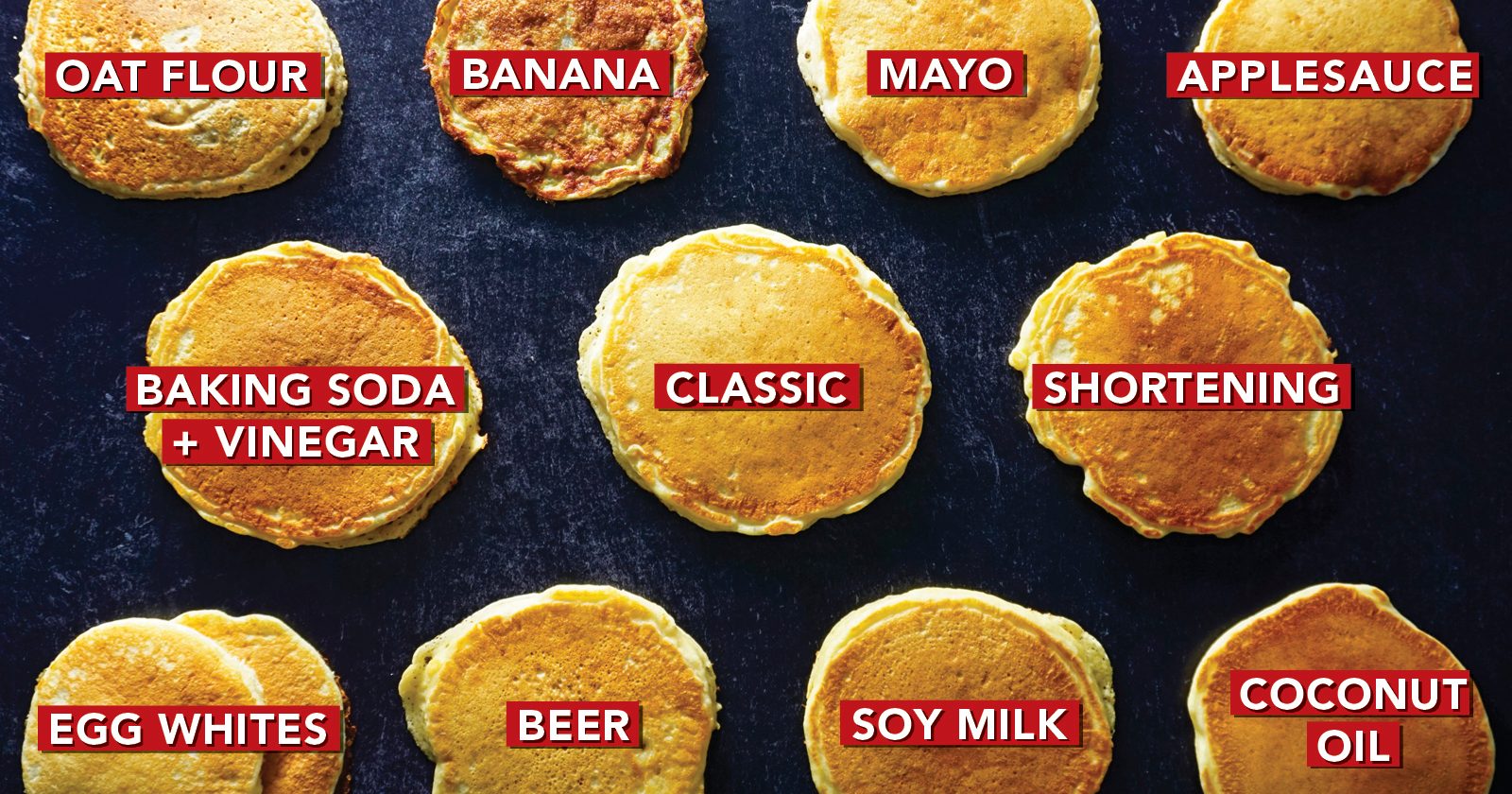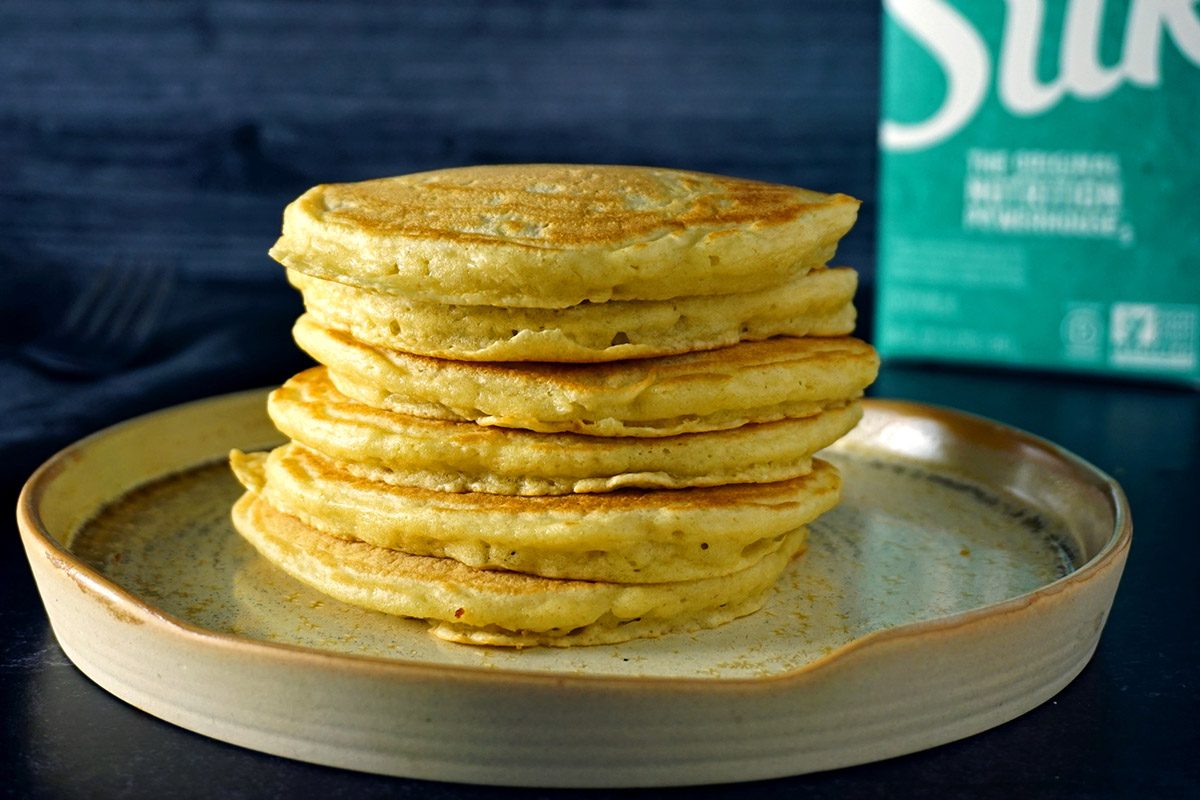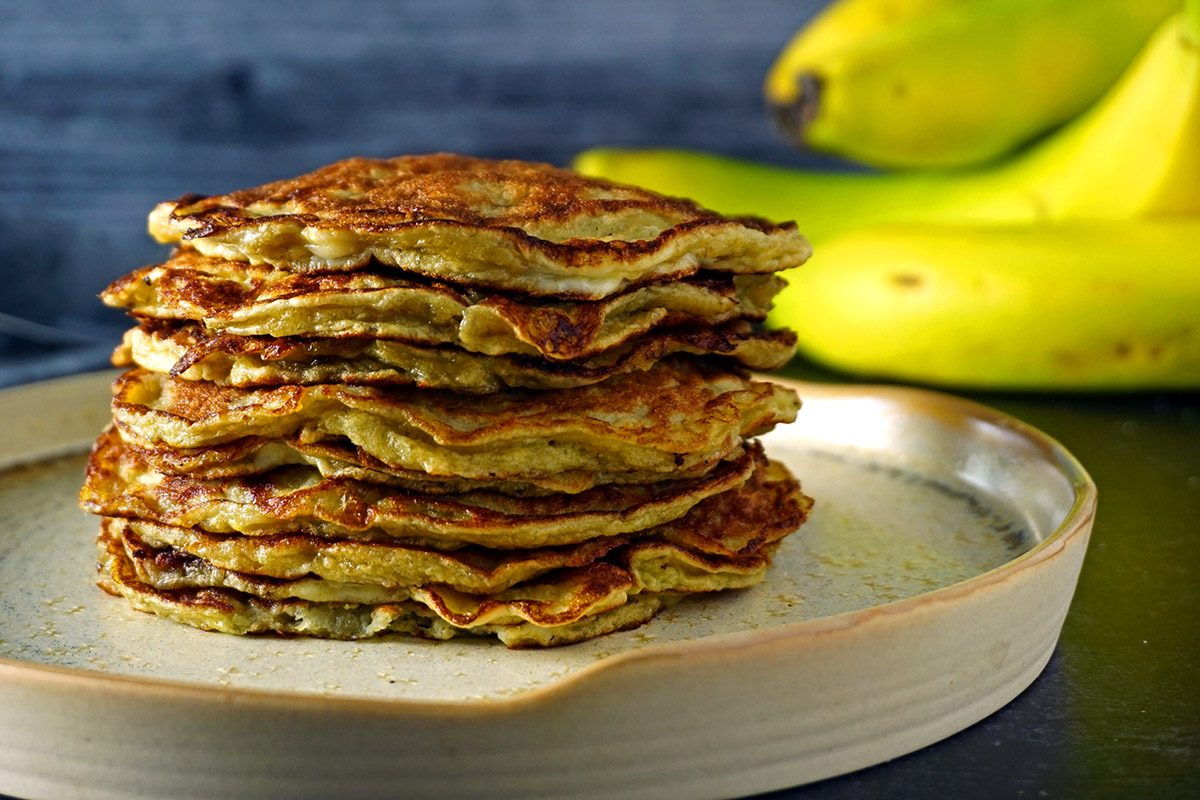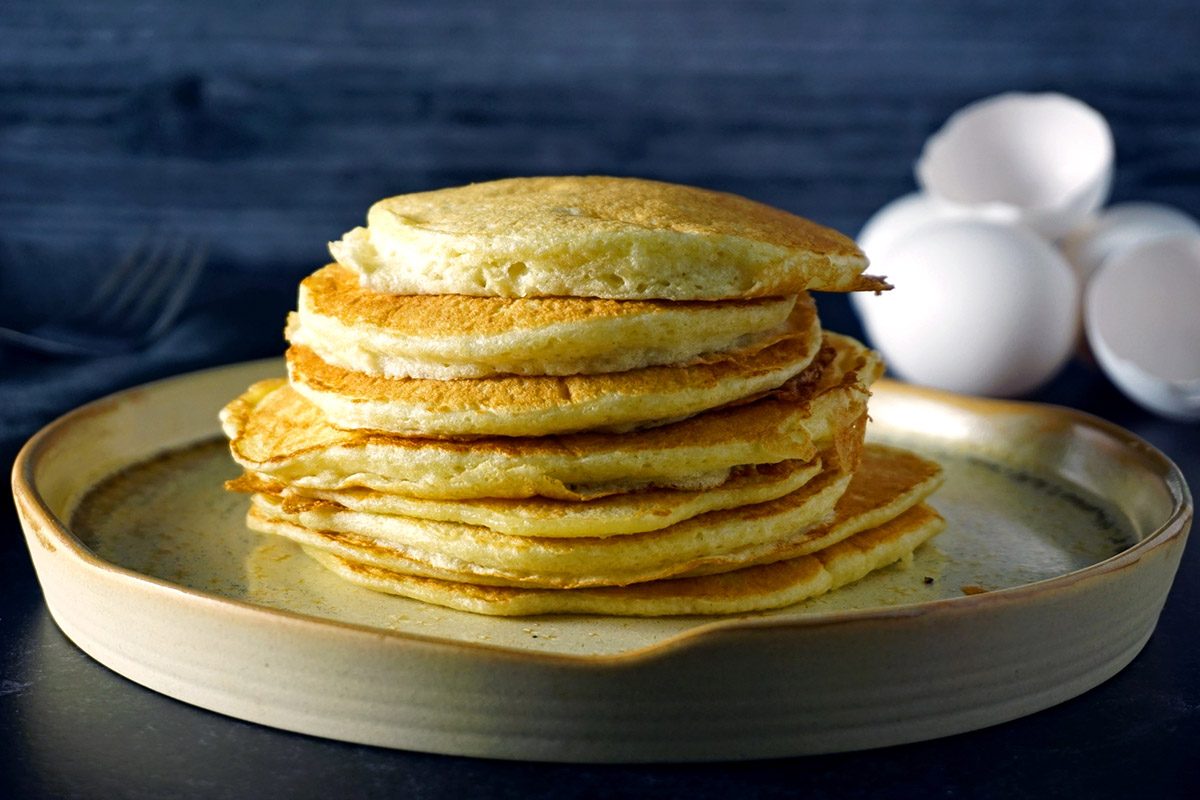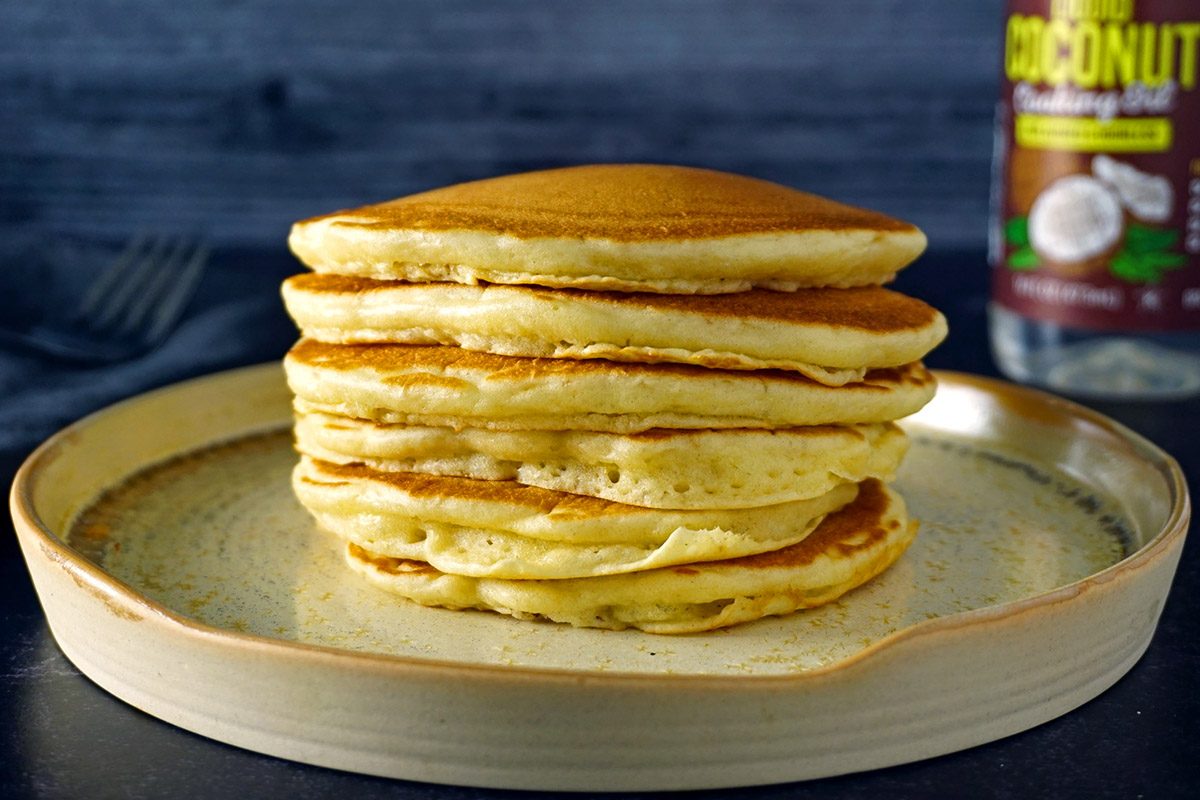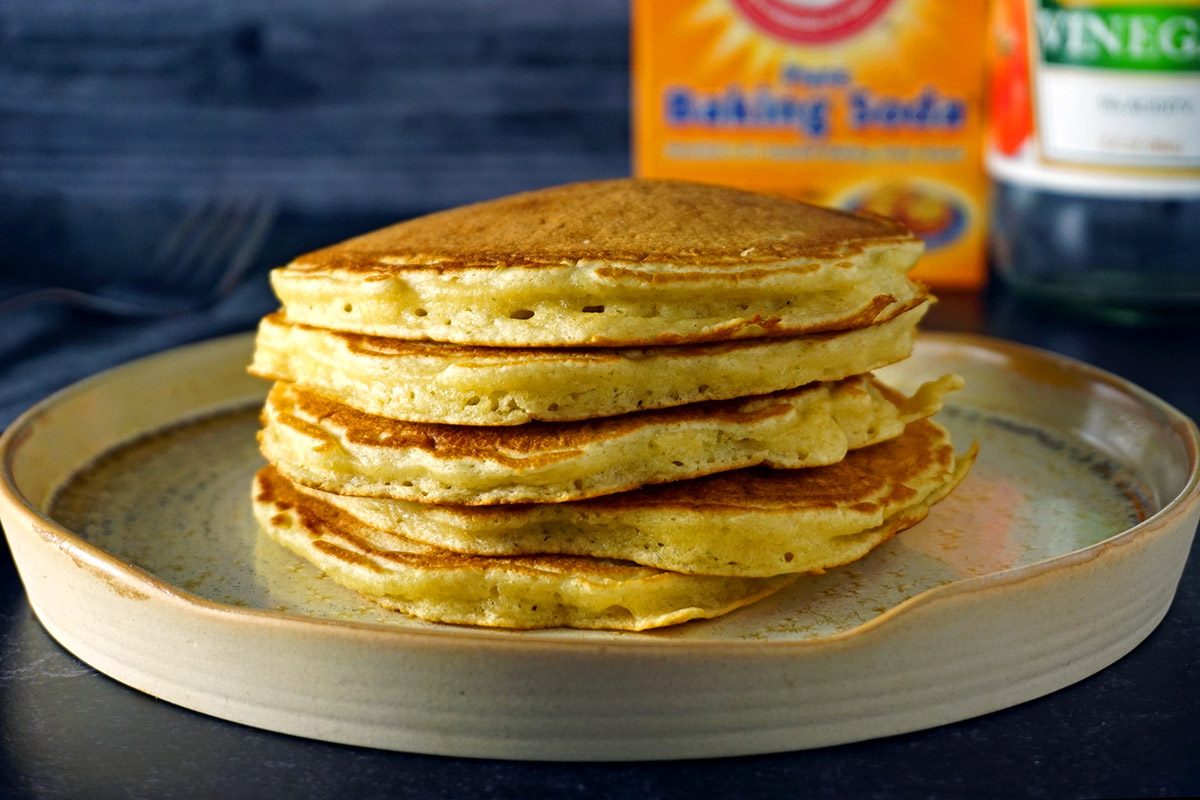There’s nothing worse than waking up Sunday morning, ready to make a batch of homemade pancakes, only to realize that you’re out of a key ingredient. But wait. Before you cancel your pancake plans and reach for a sad box of bran flakes, you should know that hope is not lost!
That’s right. You can have your pancakes (and eat them too). Often times, you can use a common kitchen staple in place of the ingredient you’re missing. Keep reading to learn what you can substitute for milk in pancakes, along with other key ingredient swaps.
The Perfect Fluffy Pancake Recipe
Before we get into ingredient substitutions, let’s walk through how to make our classic, fluffy pancake recipe. It’s a straightforward, simple recipe that yields light, tender results. While there are oodles of pancake recipes out there, this one is a great starting point if you’re looking for a fast and easy pancake, and it’s the recipe we’ve based all of our ingredient substitutions on.
Ingredients
- 2 cups all-purpose flour
- 2 tablespoons sugar
- 4 teaspoons baking powder
- 1 teaspoon salt
- 2 large eggs
- 1-1/2 cups milk
- 1/2 cup shortening or butter, melted
- 2 teaspoons pure vanilla extract
Instructions
Step 1: Mix the batter
In a small bowl, combine flour, sugar, baking powder and salt. Then, in a separate bowl, combine eggs, milk and melted butter. Next, stir the wet ingredients into the dry ingredients until just moistened. Take care not to overmix the batter.
Step 2: Cook
Pour batter by 1/4 cupfuls onto a large, greased, preheated griddle. Cook the pancakes on one side until bubbles form on top of pancakes and the edges begin to appear set. Using a spatula, carefully flip the pancakes over. Then, continue to cook until the second side is golden brown.
Pro tip: Have trouble flipping your pancakes? Try a thin, flexible spatula, like this one from OXO. Our Test Kitchen likes how it glides beneath pancakes for picture-perfect results. Bonus point: It’s made of silicone, so it won’t scratch the griddle.
Transfer cooked pancakes to a heat-safe plate and place them in the oven set to warm until all the pancakes are cooked. Serve warm with maple syrup, butter and additional pancake toppings.
How to Make Pancakes If You’re Missing Ingredients
Now that you have the basic recipe down, let’s discuss what you can substitute for milk in pancakes and other great ingredient swaps. Of course, this list is not exhaustive, and there are further ingredient substitutions. But we’ve selected options that use the ingredients that most people have on hand and will yield the best results.
Pancake Recipe Without Milk
If you’re out of milk, or need a dairy-free option for making pancakes, you can replace the milk with an equal amount of just about any other liquid. In a pinch, water is the easiest swap, but we find pancakes made with water lack flavor and richness.
Pancakes with non-dairy milk
Flavorful substitutions include dairy-free milk such as soy milk, almond milk, oat milk or cashew milk. Look for unsweetened varieties for best results; otherwise, you may also need to also reduce the amount of sugar in the recipe.
Testing Notes: Browns slower, due to lower sugar content. Fluffy with a slightly chewier texture than the classic recipe, likely due to lower fat content.
Pancakes with beer
Beer is another great milk alternative that you can also swap using a 1:1 ratio. An added benefit of beer is that its fizziness adds extra air bubbles to the batter resulting in extra fluffy pancakes. We recommend choosing a malt-heavy beer (like a lager, stout or porter) rather than a beer that’s heavy on hops. IPAs can make the pancakes taste bitter and slightly acidic.
Testing Notes: Bubbles appear quickly while cooking. Finished pancakes are extra fluffy with a better, higher rise than the classic recipe. Pancakes have a faint beer scent and flavor.
Pancake Recipe Without Flour
Yes, it is possible to make pancakes without flour. However, they might not look or taste just like the pancakes you’re used to. When finding a replacement for flour, realize you’ll have to play with measurements of the other ingredients in your recipe.
Pancakes with bananas
If you have a few ripe bananas on your counter, mash them up and add to your pancake batter in lieu of all-purpose flour. Use 1 medium banana for every cup of flour in your recipe. You’ll also want to reduce the milk in the recipe by half and double the eggs, Since bananas have a starchy, fibrous texture, they work just like gluten in flour to give pancakes the body they need. If you want yours to be a little more pancake-like and less omelet-like, you can add an additional 1/4 cup of alternative flour (like oat, rice or almond flour) to the batter.
Testing Notes: Eggy taste and texture and least fluffy of all tested substitutes. These pancakes need to cook slowly and take a delicate hand to flip successfully. The batter spreads, so as soon as it hits the hot griddle, use a non-stick spatula to reshape the batter into a round pancake as it starts to cook.
Pancakes with oat flour
Oat flour can also be used in place of regular, all-purpose flour for pancakes. But it’s not a simple 1:1 swap. To use, substitute 1-1/3 cups of oat flour for every 1 cup of all-purpose flour. That means, for the base pancake recipe above, you’ll want to use 2-2/3 cups of oat flour in place of 2 cups of flour. A benefit of using oat flour is that it’s higher in both protein and fiber than all-purpose flour. It’s also a lower-carb, gluten-free option for pancakes. Because it’s more nutrient-dense, many will find pancakes made with oat flour to be more filling.
Testing Notes: Fluffy, but denser than regular pancakes. Have a heartier, whole grain flavor, texture and appearance.
How to make oat flour: Add 2 cups of old-fashioned rolled oats (do not use quick or instant rolled oats) to a high-speed blender or a food processor and blend until finely ground. Two cups of rolled oats will yield about 1 cup of oat flour.
Pancake Recipe Without Eggs
The main purpose of eggs in pancakes is to act as a binding ingredient. The following easy substitutions have similar properties that make pancakes without eggs possible.
Pancakes with applesauce
Applesauce is a great swap if you’re out of eggs. Use 1/4 cup of applesauce per egg in the recipe. The reason applesauce works as an egg substitute is largely due to the pectin it contains. Pectin is the same binding agent used in fruit pie filling. Even if you have eggs in your fridge, you may want to consider applesauce as an egg replacement because it’s much lower in fat and cholesterol. It’s a great option if you’re trying to reduce calories and be more heart-healthy with your cooking.
Testing Notes: Brown faster due to sugar content in applesauce and not quite as fluffy as the classic recipe. Overall, no true flavor difference.
Pancakes with mayonnaise
If you’re out of eggs and want to use a secret ingredient, consider using mayonnaise. Use 3 tablespoons of mayonnaise for every egg in the recipe. Because mayonnaise is made primarily of eggs, it has a similar binding power to fresh eggs. Don’t worry about your pancakes tasting like mayo, either. The only thing you’ll notice is that they’re richer than regular pancakes which still being light and fluffy.
Testing Notes: Ultra-rich and melt-in-your-mouth tender. Extra fluffy with a very slight egg flavor.
Pancake Recipe Without Butter
When you’re low on butter, any neutral-flavored cooking oil makes an easy substitute for butter in pancakes. Use equal amounts of your selected cooking oil in place of the melted butter. Our favorite oils to use for pancakes are either vegetable oil or canola oil.
Pancakes with cooking oil or coconut oil
Another oil to consider, if you like the taste of coconut, is coconut oil. This powerhouse ingredient is unique as it is a solid at room temperature and a liquid when warmed up. Be sure to melt your coconut oil before using it in the pancake mix.
Testing Notes: Browns slightly faster but a more uniform color and appearance once cooked. Fluffy like original with the same taste and texture. A faint coconut scent is the main difference.
Pancakes with shortening
Melted shortening is another ideal swap for butter. You can use either regular shortening or go for the butter-flavored option if that’s what you keep stocked in your pantry. Shortening will yield pancakes closest to those made with butter so if you’re a stickler for that classic pancake taste and texture, shortening will be your best friend.
Testing Notes: A near twin to the classic recipe. Overall same taste, texture and flavor, but they just brown a little slower while cooking.
Pancake Recipe Without Baking Powder
You may be wondering, what does baking powder do in pancakes? This baking staple is the key leavening agent that makes pancakes rise to fluffy heights instead of being dense and gummy. It’s used for this purpose in quick breads, too.
Pancake recipe with baking soda and vinegar
While you might be out of baking powder, there’s a good chance you still have baking soda in your pantry. You can swap the baking powder for baking soda in this pancake recipe by using 1/4 teaspoon of baking soda for every teaspoon of baking powder. In this recipe that means you’ll use 1 teaspoon of baking soda total.
The key difference between baking powder and baking soda is that when using baking soda, you’ll also need to add an acid to the recipe in order to activate it. Plain, white vinegar is the acid that you likely have on hand. Add 2 teaspoons of vinegar for every 1 teaspoon of baking soda. Don’t worry about adding a vinegar taste or smell to the pancakes. This tiny amount won’t affect the taste and the smell will dissipate during cooking. Cream of tartar or lemon juice may also be used instead of vinegar.
Testing Notes: No flavor or texture change. A perfect twin!
Pancake recipe with whipped egg whites
For extra-fluffy results, whipped egg whites make a great substitute for baking powder in pancakes—whether you have some in your pantry, or not. Use 1 egg white per teaspoon of baking powder in your recipe. To use egg whites, beat them with an electric mixer until soft peaks form. Then gently fold them into the batter until combined. Take care not to overmix, which will deflate the egg whites. Egg whites will yield super light and airy pancakes with a great rise.
Testing Notes: Strong egg flavor but with an incredibly fluffy, souffle-like texture. Work quickly when using whipped egg whites since the batter tends to deflate as it sits, which will cause pancakes to lose their overall fluffiness.
Note: Recipes submitted by our trusted contributors are created and tested in their kitchens.
The post How to Make Pancakes with What You Have on Hand appeared first on Taste of Home.
Lauren Habermehl
